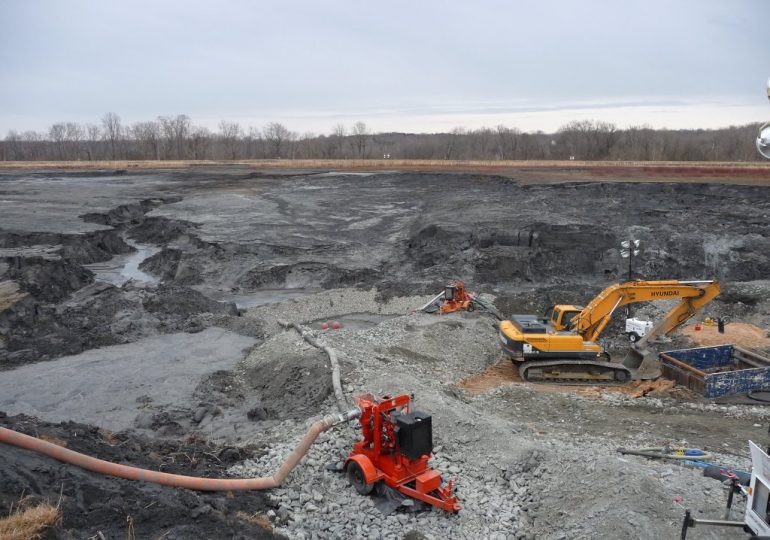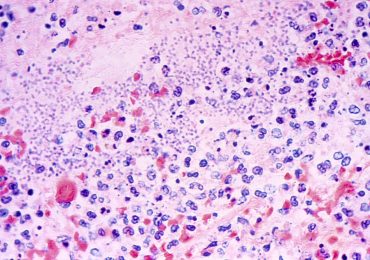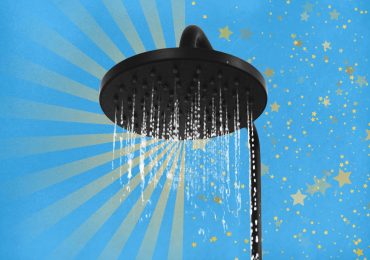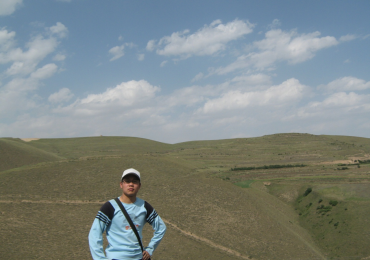Environmental advocates say new rules announced Thursday by the U.S. Environmental Protection Agency should close a loophole that has helped power plant operators skirt responsibility for toxic coal ash pollution at scores of sites nationwide.
Two rules — part of a suite of new regulations on fossil fuel power plants that also include the first-ever carbon emissions limits — may offer the broadest tools yet for forcing cleanup of hundreds of ponds, landfills, and impoundments known to be holding coal ash, a byproduct of burning coal.
Coal ash has been piling up for more than a century wherever coal has been burned as an energy source. Some has wound up in landfills. Some has been repurposed as construction fill. Some still sits in unlined ponds or piles next to power plants. It was mostly unregulated until recent years as its danger to public health became better known.
The initial attempts to regulate coal ash were incomplete. The U.S. EPA’s 2015 coal ash rules covered only active repositories — exempting about half of all known dump sites including landfills, ponds closed before 2015, and sites where ash was scattered or dumped. Advocates have fought to expand the rules ever since.
The new, finalized Coal Combustion Residuals (CCR) rule essentially prohibits any pollution of groundwater or water bodies by coal plant sites, regardless of the exact source.
Meanwhile the new Effluent Limitation Guidelines (ELGs) address wastewater released from power plants, including water used to clean bottom ash out of boilers. The effluent rules, proposed last spring, represent the first-ever regulations on coal plant wastewater, which includes contaminated water that has seeped through coal ash, and water drained from coal ash impoundments in preparation for closing.
Companies have been able to avoid cleaning up even regulated coal ash ponds that were leaking, by blaming groundwater contamination on nearby unregulated coal ash sources, environmental attorneys have long argued.
“So there’s a huge loophole that we will hopefully be closing,” said Environmental Integrity Project senior attorney Abel Russ during one of two online press conferences held by environmental attorneys and advocates before the rules’ release. “What EPA proposed would require basically sitewide corrective action and cleanup, whatever the source is, and owners will no longer be able to point to an unregulated unit and avoid a cleanup. This will also lead to clean up plans that are actually going to do what they’re supposed to do, which is restore groundwater quality.”
“We’ll finally eliminate the shell game of ‘Oh contamination came from that pile, not this pile,’” added Frank Holleman, coordinator of the Southern Environmental Law Center’s regional coal ash initiative. “The utilities will finally step up to the plate and be law-abiding citizens, and clean up this historic mess that the utilities are well capable of cleaning up and which should have been cleaned up years and years ago.”
The new rule will also for the first time regulate “historic” coal ash that has been scattered and dumped around coal plant sites and even in surrounding communities, often without records even being kept.
“It may be underlying buildings, it may be underlying playgrounds, it’s basically everywhere,” said Sierra Club staff attorney Megan Wachspress. “The first step under the rule is for coal plant operators to actually figure out and delineate where this stuff is. When we talk about implementation, that’s making sure all of this dumped ash actually becomes accounted for.”
‘Necessary and complementary’
Earthjustice senior attorney Lisa Evans praised the new rules, but noted that change depends on meaningful enforcement. Indeed, the 2015 federal rules were barely enforced until 2022, when the Biden administration’s EPA began issuing denials of cleanup extension requests and violation notices to coal ash site operators.
Attorneys said the coal ash and ELG rules work in tandem, with the coal ash rules covering groundwater near coal ash impoundments, and the ELG rules addressing surface water near power plants — both coal and new gas plants.
“The two rules are necessary and complementary to each other and point in the same direction, which is that they are contaminating groundwater, they’re contaminating the surface waters that run alongside them,” said Earthjustice attorney Thom Cmar. “Both standards work in complementary ways to set a high bar that points toward cleanup and environmental protection to make sure these dangerous sites are fully cleaned up.”
Holleman said that for decades, the powerful coal industry has avoided taking seemingly obvious precautionary measures.
“If you have solid waste with toxic substances in it, you can’t dump it in an unlined pit below the water table sitting next to a river, you’ve got to put it in a modern landfill,” said Holleman. “That’s true even with kitchen garbage in America. And secondly, if you discharge water containing toxic substances like arsenic, mercury, you’ve got to treat it before you discharge it in the river. That is the sum total, in many ways, of these two rules. That is not cutting edge. That’s just the basic, environmentally responsible – and I’d say humanely moral – thing to do.”
While advocates said they are pleased with the attention the Biden administration and specifically EPA Administrator Michael Regan have paid to coal ash, they worry gains could be precarious.
“If the next administration [has] no interest in enforcement, the public interest community will carry a very heavy burden,” said Evans, citing various measures taken by the Trump administration to weaken the federal coal ash rules and other coal-related protections. If Trump is elected in 2024, she said, “I have no doubt that the administration will either try the same thing again or not enforce the rule, which would be disastrous.”
While the coal ash rule would force the cleanup of coal plant sites even after the plants close, the wastewater rules could force companies to implement expensive pollution controls, or decide to close rather than making the investment.
“It makes a lot of sense for coal plant operators to really take a hard look at the economics of retiring rather than expending additional funds, oftentimes captive ratepayer funds, retrofitting these units,” said Sierra Club senior attorney Joshua Smith.
Activist Dulce Ortiz said the new coal ash rules could help reverse the “painful history” of industrial pollution in her home of Waukegan in northern Illinois, the site of five of Illinois’s 11 Superfund sites. Ortiz and others have been demanding the cleanup of coal ash at a shuttered NRG coal plant on the Lake Michigan shore, with little response.
“Waukegan has dreamed for years and still does dream of revitalizing our lakefront. We have aspirational lakefront plans that have seen little to no success in coming to fruition in part because of the amount of contamination that remains at many of these sites… When we allow companies to pollute our communities and not force them to clean up, we deter future investment in these sites and our communities at large.”
Ortiz, founder of Clean Power Lake County and a Waukegan Township trustee, continued that, “My vision for my family and my community is that I can take my children swimming in Lake Michigan without worrying about toxic pollution, groundwater pollution…A lakefront with open space that respects our environment, where corporate profit does not override the health needs of our families… I want to see a clean energy future for Waukegan and all communities that have borne the brunt of coal ash pollution for decades.”
New EPA rules close a ‘huge loophole’ on coal ash, forcing wide-scale cleanup, advocates say is an article from Energy News Network, a nonprofit news service covering the clean energy transition. If you would like to support us please make a donation.
Leave a comment





